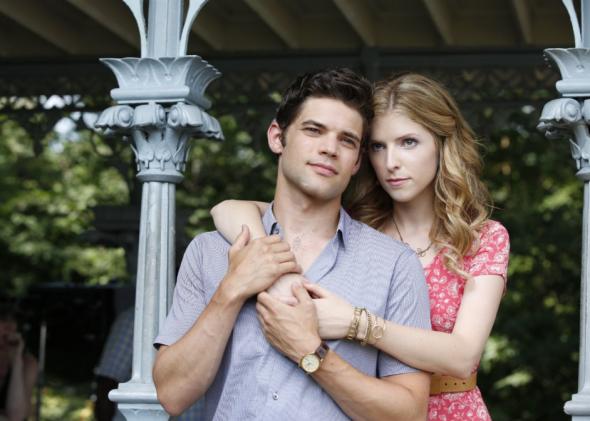I’m a Lifelong Last Five Years Fan. Here’s Why It Was So Hard for Me To Watch the Movie.

Jeremy Jordan and Anna Kendrick in The Last Five Years.
This weekend, most of the movie-going nation will flock to Fifty Shades of Grey. But a far smaller fraction will nervously and excitedly purchase tickets for another film adaptation of a work that is similarly sexy and funny and freighted with cultural baggage: The Last Five Years, a modest, chronologically confusing cult-classic musical about a half-decade-long relationship between a novelist named Jamie Wellerstein and an aspiring actress named Cathy Hiatt.
To many people who have gone through a musical-theater phase—mine was approximately contemporaneous with my high-school years—Jamie and Cathy are as canonical a couple as Romeo and Juliet, Elizabeth and Mr. Darcy, or Rick and Ilsa. To say that everything I know about love I learned from the 2002 off-Broadway cast recording of The Last Five Years would be an exaggeration, but only slightly. Jason Robert Brown’s musical, which is widely understood to be a fictionalized account of his first marriage, is one of the most honest, generous depictions of a romantic relationship I’ve ever encountered.
The brilliance of The Last Five Years is twofold. First is the time-twisting narrative conceit: Cathy tells her side of the story moving backward in time, starting with their breakup, while Jamie moves forward in time. In stage productions, each character is alone on stage during their numbers, and the audience is left to fill in the blanks, and to imagine what the other spouse might be thinking or saying in response. Both Jamie and Cathy are unreliable narrators, and it’s not totally clear the first time you listen to or watch The Last Five Years—or the fiftieth—exactly what transpires when in their marriage. And now the film version has immortalized Jamie and Cathy in a way that is at once moving and insightful and—whether you are a newcomer or a longtime fan—totally bewildering.
In the play, the subjectivity of each number underpins the sympathy Brown extends to both of his protagonists, which is the second thing that makes The Last Five Years so exceptional. Cathy and Jamie are both flawed but relatable and even endearing. Jamie’s a talented writer and a doting lover, but he’s also a horndog. Cathy’s a go-getter with a charmingly self-deprecating side, but she’s prone to possessiveness. They both have razor-sharp wits and narcissistic tendencies. You will probably side with one character over the other at first, but as you listen and re-listen, your alliances will shift, because both Jamie and Cathy are just so human. As director Richard LaGravenese told me when I interviewed him for Slate Voice last week, “The movie is kind of a litmus test for where you are in relationships.”
LaGravenese has gone to great lengths to preserve the text of the musical, and he worked closely with Brown on his adaptation. The movie is an exceptionally faithful adaptation of the stage version; LaGravenese added virtually no dialogue, and doesn’t even hold viewers’ hands with title cards explaining which year each scene takes place. As a result, audiences who aren’t already familiar with The Last Five Years shouldn’t expect to make immediate sense of the movie, which LaGravenese told me he intended to feel like a mosaic of Jamie and Cathy’s relationship.
This isn’t to say that the uninitiated should avoid The Last Five Years for fear of being confused: The movie is a fine entrée to the pleasures of the musical, and the intimacy of the camera lends some scenes additional depth and nuance. Anna Kendrick isn’t my ideal Cathy, with her birdlike physiognomy and occasionally reedy voice, but she is appropriately spunky and sly as Cathy in her early twenties. Jeremy Jordan is perfectly cast as Jamie, thanks to his broad, handsome, expressive face and slick-bordering-on-smarmy charm. Jordan’s delivery of “The Schmuel Song”—a strange, invented folk tale that Jamie tells Cathy to cheer her up near the end of the first half of the show—is vibrant and surprisingly down-to-earth. And in “Nobody Needs to Know”—a late number tinged with regret bordering on horror—Jordan makes Jamie’s self-pity feel so raw that you can’t help but feel for him, even though he’s obviously being a jerk.
As a longtime devotee of The Last Five Years, it was a foregone conclusion that I would enjoy watching the movie—but I felt unsettled by it, too. LaGravenese painstakingly preserved Brown’s asynchronous storytelling and his witty lyrics, carefully building a scene around each song without taking too many liberties. But in building each scene—in the very act of filmmaking—LaGravenese has sacrificed some of the subjectivity that made the musical feel like a unique treasure. On screen, there is no guessing about what Jamie tells Cathy that makes her so angry in the middle of “See I’m Smiling,” or about how Cathy reacts to Jamie’s mansplaining anthem “If I Didn’t Believe in You.” It’s all there, in front of our eyes, with nothing left to the imagination. It’s not just Jamie and Cathy’s subjectivity that dissolve during the movie, as each one of their claims about the other becomes verifiable; it’s the audience’s subjectivity, too, our freedom to identify fully with whoever is singing at any given moment.
There is nothing LaGravenese could have done to prevent this from happening, short of shooting each song as a one-person monologue on an empty stage, which would have been very boring and pointless as a cinematic exercise. I’m glad his movie, a true passion project, will introduce more people to The Last Five Years. But I hope that after seeing the movie, people will download the soundtrack—or the 2002 cast recording, or the 2013 cast recording with Betsy Wolfe and Adam Kantor—and lose themselves in it, so they can forget some of what they’ve just seen.

